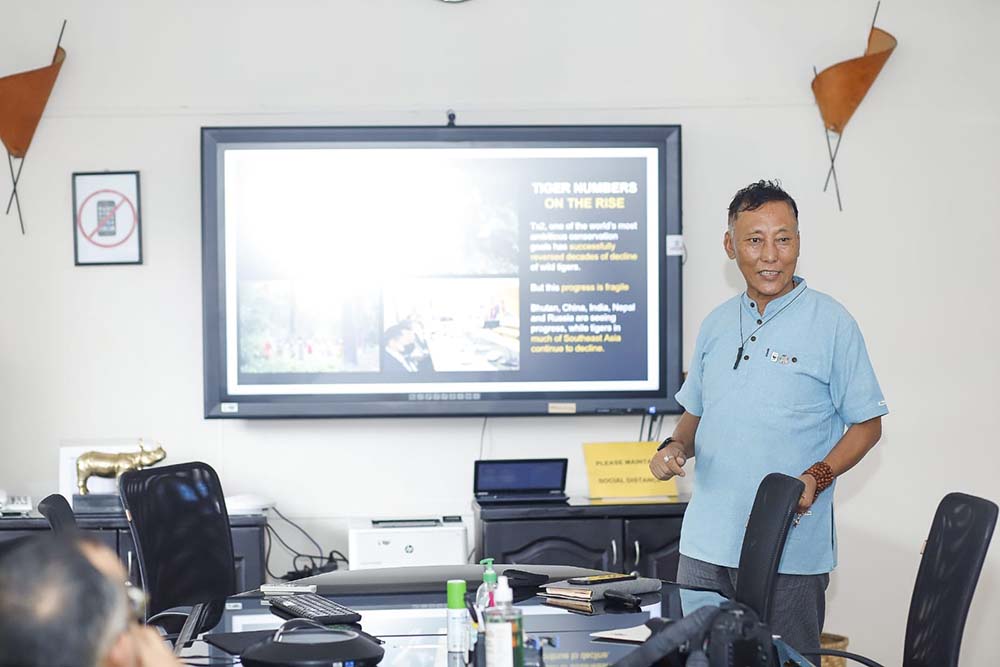
KATHMANDU: World Wildlife Fund (WWF) Nepal held an interaction programme with the title 'WWF Tigers Alive Initiative - Strategy 2023-34' on Friday on the occasion of Global Tiger Day which falls on July 29. The interaction programme was held to share the real scenario of the increment of tiger population, realise the challenges it may create and possible solutions that could be taken forward. Ghana Shyam Gurung, Country Representative of World Wildlife Fund (WWF) Nepal, speaks at a programme organised on the occasion of Global Tiger Day in Kathmandu, on Friday, July 28, 2023. Photo: Sanjay Maharjan/Media9[/caption] Starting the programme, Ghana Shyam Gurung, Country Representative of WWF Nepal, stated, “We are happy to announce that we have become successful in increasing the tiger population beyond the target. WWF Nepal works with 12 countries, we do not talk about Nepal only, we talk about the rest of the nations too. According to the latest census of 2022, the world’s tiger population is 4,500 and we have a target of 6,000 in the next census. Therefore, we are still working on it.” Nepal has declared an impressive result by tripling the tiger population and contributing to the world’s number. In the meantime, we cannot omit the contribution of China, Bhutan, India, and Russia. They have either doubled or tripled the population of tigers which is a very good sign. Gurung said, "The tiger population is becoming an issue but the actual issue should be management, protection and conservation of the tigers. And to do that, the focus should be on their habitat management, controlling poaching and trade of their body parts." [gallery columns="2" link="file" size="full" ids="39986,39985"] Shiv Raj Bhatta, Conservation Director of WWF Nepal, said the coexistence of wildlife with humans and infrastructure, which is a new concept, is the key to the conservation of tigers. WWF Nepal Representative Gurung suggested five major components in terms of management and coexistence to cope with challenges posed by the increased population of tigers and the conflict between humans and big cats. He emphasized the importance of behavioural awareness among human beings and suggested running campaigns like Behaviour Communication. Secondly, proper availability of wetlands, rivers and grasslands should be ensured in order to provide the big cats with better habitats. He asserted that tigers encroach upon human settlements when they don't see themselves in their own habitat. He stressed the importance of visitor management and establishing a strong monitoring system. The rescue and relief to the animal attack survivors cannot be ignored he said and added that advocacy should be ongoing. Gurung opined that the increase in the tiger population was positive and urged all not to spread the negative message about it. READ ALSO:
Ghana Shyam Gurung, Country Representative of World Wildlife Fund (WWF) Nepal, speaks at a programme organised on the occasion of Global Tiger Day in Kathmandu, on Friday, July 28, 2023. Photo: Sanjay Maharjan/Media9[/caption] Starting the programme, Ghana Shyam Gurung, Country Representative of WWF Nepal, stated, “We are happy to announce that we have become successful in increasing the tiger population beyond the target. WWF Nepal works with 12 countries, we do not talk about Nepal only, we talk about the rest of the nations too. According to the latest census of 2022, the world’s tiger population is 4,500 and we have a target of 6,000 in the next census. Therefore, we are still working on it.” Nepal has declared an impressive result by tripling the tiger population and contributing to the world’s number. In the meantime, we cannot omit the contribution of China, Bhutan, India, and Russia. They have either doubled or tripled the population of tigers which is a very good sign. Gurung said, "The tiger population is becoming an issue but the actual issue should be management, protection and conservation of the tigers. And to do that, the focus should be on their habitat management, controlling poaching and trade of their body parts." [gallery columns="2" link="file" size="full" ids="39986,39985"] Shiv Raj Bhatta, Conservation Director of WWF Nepal, said the coexistence of wildlife with humans and infrastructure, which is a new concept, is the key to the conservation of tigers. WWF Nepal Representative Gurung suggested five major components in terms of management and coexistence to cope with challenges posed by the increased population of tigers and the conflict between humans and big cats. He emphasized the importance of behavioural awareness among human beings and suggested running campaigns like Behaviour Communication. Secondly, proper availability of wetlands, rivers and grasslands should be ensured in order to provide the big cats with better habitats. He asserted that tigers encroach upon human settlements when they don't see themselves in their own habitat. He stressed the importance of visitor management and establishing a strong monitoring system. The rescue and relief to the animal attack survivors cannot be ignored he said and added that advocacy should be ongoing. Gurung opined that the increase in the tiger population was positive and urged all not to spread the negative message about it. READ ALSO:





